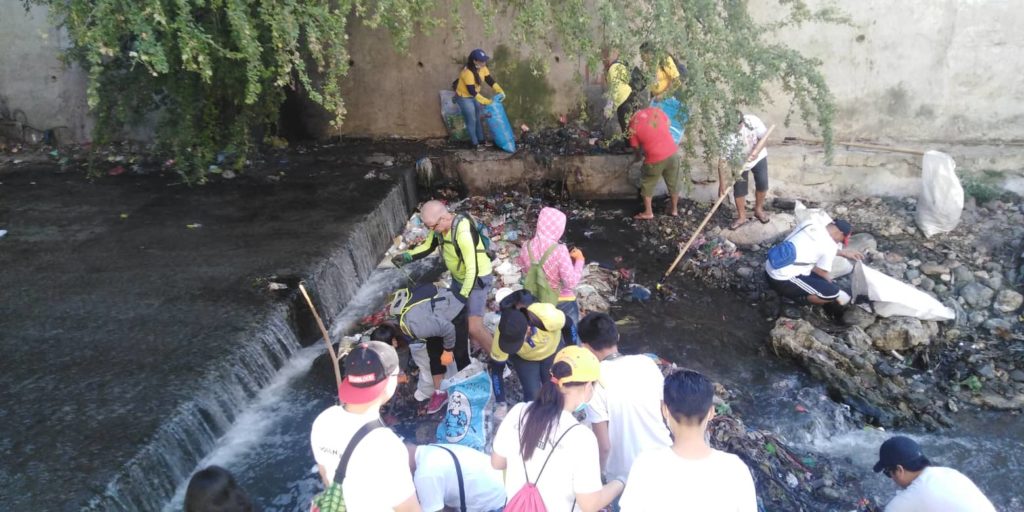
Volunteers spend their Saturday morning, Feb. 22, 2019, helping in the cleanup of Bulacao River in Cebu City spearheaded by the Cebu City Environment and Natural Resources Office (Cenro). | CDND Photo/Delta Dyrecka Letigio
CEBU CITY, Philippines — Cebu City’s major river systems are dirty and unsafe for the public, especially the downstream.
This was the report of the representative of the City Environment and Natural Resources (CENRO) and the Environment and Management Bureau in Central Visayas (EMB-7) during the first day of the River Summit in Cebu City.
Kay Espinosa of the EMB-7 said that based on their testing, most of the rivers especially the downstream have tested positive for fecal matter.
This means that the water in the city’s rivers is not safe for bathing or drinking by the public.
“In general, our water quality shows that many of our rivers suffer a high level of fecal coliforms. Tungod kay high level of fecal coliform, it shows nga naa tay wastes from warm blooded animals particularly sa mga toilet nato, mga animals, mga baboy,” said Espinosa.
Espinosa notes that water quality can change through time and the seven river systems differ from each on the quality of water, but generally, the public is not advised to use the water of any of the downstream rivers in the city.
Still, the EMB-7 believes there is hope in reversing the current condition of the river systems through a concrete and intensive plan to rehabilitate them.
Espinosa said the rivers are not yet biologically dead, and there remains hope to save them.
The EMB-7 is grateful to the Cebu City government for holding the River Summit that brings together all stakeholders to discuss the current state of the rivers and the long-term plan to save them.
“As long as we have programs and projects, and we work closely with our stakeholders, there is hope for our rivers. We are looking forward that the summit will encourage the city government, also our stakeholders, to work together in the implementation of different laws and programs to improve the water quality of our rivers,” said Espinosa.
Engineer Myka Marie Llanos of the CCENRO, said that seven river systems in the city span various areas and even border the city.
Some rivers are long and stretch from the mountain barangays to the sea, while others are mainly situated in urban areas.
“We have the problems in the upstream areas where grabe ang septage problems. Magbuhi ang mga tawo without proper septic facilities. And then midstream, we have drought because of the current situation in the mountains with extreme tree cutting and we also have mining, quarrying, especially sa river beds nato. Wala man ta nagdili ana, pero it’s an alarming issue. There should be measures ba.”
“Midstream walay nay water kay dili na healthy atong watersheds. Sa atong downstream, it’s supposed to be the most critical because mao ni nga area nga marelease sa dagat. Ang magic naa dinha, daghan tag tubig sa downstream because we have untreated wastewater released to our rivers,” she said.
Llanos said that the conditions affecting the riverways can be improved only if there is a collaboration between the barangays, the local government unit (LGU), and the private stakeholders.
CCENRO has been conducting information dissemination in the communities, but without the will of the people to help, it will be difficult to implement the ordinances of the city.
However, the agency cannot monitor all the time the riverside communities that are seen to be the major contributants to the garbage and septic problems of the rivers.
The agency has talked with barangays in deputizing barangay personnel to cite violators of the anti-littering ordinances especially households that throw their garbage directly into the river.
CCENRO hopes that by empowering the barangay, it will be one of the long-term solutions to the perennial problem.
Llanos added that the River Summit is a chance for CCENRO to engage with stakeholders and present the realities of the river systems in hopes to get their commitment.
CCENRO hopes that after the two-day convention, they will be able to influence the stakeholders to care for the rivers’ rehabilitation. /rcg
RELATED STORY:
River summit begins in Cebu City